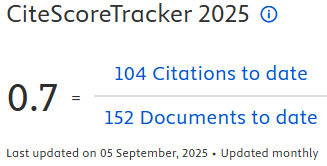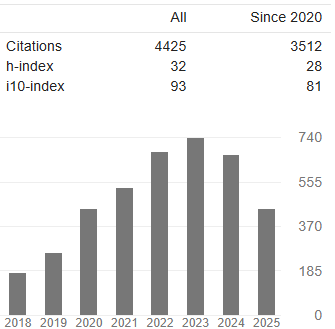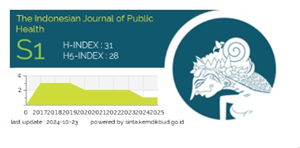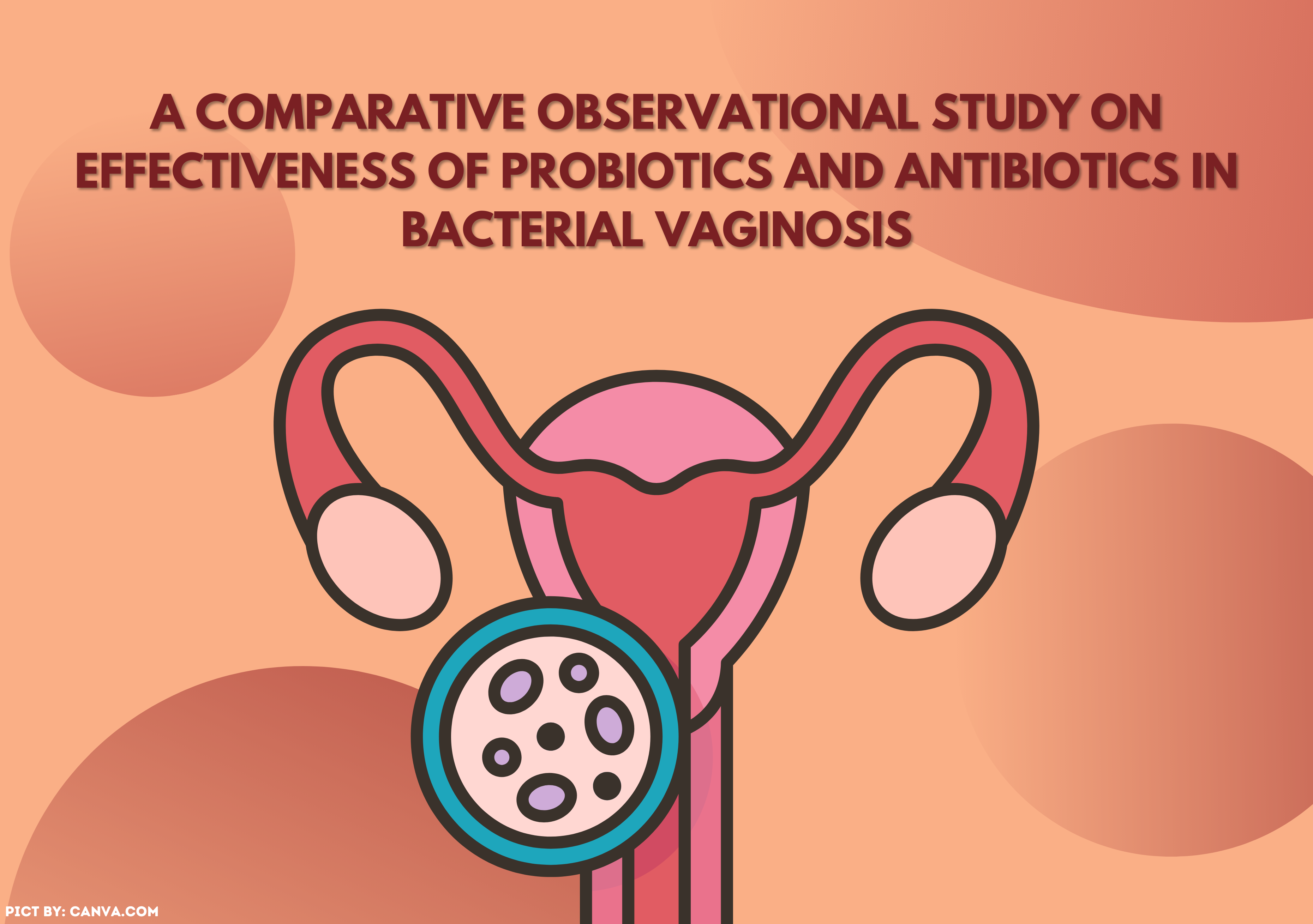HUBUNGAN STATUS GIZI, ANEMIA DAN PARITAS TERHADAP BERAT BAYI LAHIR DI KECAMATAN SEMAMPIR KOTA SURABAYA TAHUN 2016
Downloads
Alya, D. 2014. Faktor-faktor yang Berhubungan dengan Bayi Berat Lahir Rendah (BBLR) di Rumah Sakit Ibu dan Anak Banda Aceh Tahun 2013. Skripsi. STIKes U'Budiyah Banda Aceh.
Andrian, D., Ezy, Z.N. 2015. Hubungan Umur dan Paritas Ibu dengan Kejadian Berat Badan Lahir Rendah di Rumah Sakit Umum Daerah Dr Ahmad Mochtar Kota Bukittinggi Tahun 2014. Jurnal Ilmu Kesehatan ‘Afiyah, Vol. 2 No. 2.
Anggarani, D.R., Subakti, Y. 2013. Kupas Tuntas Seputar Kehamilan. Jakarta: PT Agro Media Pustaka.
BPS. 2012. Angka Kematian Bayi (AKB). Jakarta: Badan Pusat Statistik.
Dinkes Kota Surabaya. 2015. Profil Kesehatan Kota Surabaya Tahun 2015. Surabaya: Dinas Kesehatan Kota Surabaya.
Dinkes Provinsi Jawa Timur. 2015. Profil Kesehatan Provinsi Jawa Timur Tahun 2014. Surabaya: Dinas Kesehatan Provinsi Jawa Timur.
Endriana, S.D., Indrawati, N.D., Rahmawati, A. 2012. Hubungan Umur dan Paritas Ibu dengan Berat Bayi Lahir di RB Citra Insani Semarang Tahun 2012. Jurnal Kebidanan, Vol. 2 No. 1: 77-83. [https://doi.org/10.26714/jk.2.1.2013.%25p].
Faqih, A. 2010. Kependudukan – Teori, Fakta dan Masalah. Yogyakarta: Dee Publish.
Hartanti, A. 2010. Hubungan Anemia Ibu Hamil Trimester III dengan Kejadian Bayi Berat Lahir Rendah (BBLR) di RSUD Pandan Arang Boyolali. Karya Tulis Ilmiah. Universitas Sebelas Maret Surakarta.
Karima, K., Achadi, E.L. 2012. Status Gizi Ibu dan Berat Badan Lahir Bayi. Jurnal Kesehatan Masyarakat Nasional, Vol. 7 No. 3: 111-119. [http://dx.doi.org/10.21109/kesmas.v7i3.57].
Kemenkes RI. 2014. Riskesdas 2013. Jakarta: Badan Penelitian dan Pengembangan Kesehatan Kemenkes RI.
Kemenkes RI. 2015. Profil Kesehatan Indonesia 2014. Jakarta: Pusat Data dan Informasi Kesehatan.
Kemenkes RI. 2016. Situasi Balita Pendek. Jakarta: Pusat Data dan Informasi Kesehatan.
Kusmawati, N. 2012. Hubungan Status Gizi Ibu Hamil dengan Kejadian Bayi Berat Lahir Rendah (BBLR) di RSUD DR. Zainoel Abidin Banda Aceh Tahun 2012. Skripsi. Universitas Syiah Kuala Darussalam Banda Aceh.
Lidiya, A. 2016. Hubungan Anemia pada Ibu Hamil dengan Berat Badan Bayi Lahir di RSUD Dr. H. Moch. Ansari Saleh Banjarmasin Tahun 2015. Skripsi. STIKES Sari Mulia Banjarmasin.
Lusiana, N., Andriyani, R., Megasari, M. 2015. Buku Ajar Metodologi Penelitian Kebidanan. Yogyakarta: Deepublish.
Mahayana, S.A.S., Chundrayetti, E., Yulistini. 2015. Faktor Risiko yang Berpengaruh terhadap Kejadian Berat Badan Lahir Rendah di RSUP Dr.M. Djamil Padang. Jurnal Kesehatan Andalas, Vol. 4 No.3: 664-673.
Mahu, S.D. 2016. Hubungan antara Usia dan Jumlah Paritas pada Ibu Bersalin dengan Kejadian BBLR di RSUD Ben Mboi Ruteng. Skripsi. Universitas Airlangga Surabaya.
Manuaba, I.B.G., Manuaba, I.A.C., Manuaba, I.B.G.F. 2007. Pengantar Kuliah Obstetri. Jakarta: Penerbit Buku Kedokteran EGC.
Manuaba, I.B.G. 2010. Ilmu Kebidanan, Penyakit Kandungan dan Keluarga Berencana untuk Pendidikan Bidan. Jakarta: Penerbit Buku Kedokteran EGC.
Mariyatul, Triawanti, Noor, M.S. 2014. Hubungan Status Gizi Ibu Hamil dengan Kejadian Bayi Lahir Mati di Kabupaten Banjar Periode 2011 – 2012. Jurnal Publikasi Kesehatan Masyarakat Indonesia, Vol. 1 No. 1: 52-59. [http://dx.doi.org/10.20527/jpkmi.v1i1.601]
Ohlsson, A., Shah, P. 2008. Determinants and Prevention of Low Birth Weight: A Sypnosis of The Evidence. Canada: Institute of Health Economics.
Pinontoan, V. M., Tombokan, S.G.J. 2015 Hubungan Umur dan Paritas Ibu dengan Kejadian Bayi Berat Lahir Rendah. Jurnal Ilmiah Bidan, Vol. 3 No. 1: 20-25.
Sinsin, I. 2008. Seri Kesehatan Ibu dan Anak Masa Kehamilan dan Persalinan. Jakarta: PT Elex Media Komputindo.
Soetjiningsih. 1995. Tumbuh Kembang Anak. Jakarta: Penerbit Buku Kedokteran EGC.
Sunarti, E. 2004. Mengasuh dengan Hati Tantangan yang Menyenangkan. Jakarta: PT Elex Media Komputindo.
Suryaningsih, A. 2010. Faktor-faktor yang Mempengaruhi Berat Badan Lahir Bayi di RSU DR. Soetomo Surabaya. Skripsi. Universitas Airlangga Surabaya.
Suwarni, Y., Noor, M.S., Rahayu, A. 2016. Hubungan Antara Paritas, LILA, Kadar Hb dan Usia Ibu Hamil dengan Berat Lahir Bayi (Studi Observasi di Kecamatan Pelaihari Kabupaten Tanah Laut Periode Tahun 2012). Journal of Public Health Publivations Indonesia, Vol. 1 No. 1: 60-66.
Syafrudin, Hamidah. 2009. Kebidanan Komunitas. Jakarta: Penerbit Buku Kedokteran EGC.
Trihardiani, I., 2011. Faktor Risiko Kejadian Berat Badan Lahir Rendah di Wilayah Kerja Puskesmas Singkawang Timur dan Utara Kota Singkawang. Skripsi. Universitas Diponegoro.
Turhayati, E. R. 2006. Hubungan Pertambahan Berat Badan Selama Kehamilan dengan Berat Lahir Bayi di Sukaraja Bogor Tahun 2001 – 2003. Jurnal Kesehatan Masyarakat Nasional, Vol. 1 No. 3: 139-144. [http://dx.doi.org/10.21109/kesmas.v1i3.310].
Wahyuningrum, T., Saudah, N., and Novitasari, W.W. 2013. Hubungan Paritas dengan Berat Bayi Lahir di Rumah Sakit Umum Daerah DR. Wahidin Sudiro Husodo Mojokerto. Jurnal Kebidanan Widwiferia, Vol. 1 No. 2: 87-92. [http://doi.org/10.21070/mid.v1i2.352].
Widyastuti, P., 2009. Faktor-Faktor Risiko Ibu Hamil yang Berhubungan dengan Kejadian BBLR (Studi Kasus di Wilayah Kerja Puskesmas Ampel 1 Boyolali Tahun 2008. Skripsi. Universitas Negeri Semarang.
Wijaya, R.S., Elrifda, S., Noerjasin, H. 2013. Hubungan Anemia Ibu Hamil dengan Kejadian Bayi Berat Lahir Rendah. Artikel Ilmiah. Universitas Jambi.
Yulianti, I., Hargiono, R.A. 2016. Hubungan Status Gizi Ibu Hamil dengan Kejadian Berat Badan Lahir Rendah (BBLR) di RSUD DR Wahidin Sudirohusodo Kota Mojokerto. SURYA Vol. 8 No. 3: 56-62.
- The authors agree to transfer the transfer copyright of the article to The Indonesian Journal of Public Health effective if and when the paper is accepted for publication.
- Authors and other parties are bound to the Creative Commons Attribution-NonCommercial-ShareAlike 4.0 International License for the published articles, legal formal aspect of journal publication accessibility refers to Creative Commons Attribution-NonCommercial-ShareAlike 4.0 International License (CC BY-NC-SA), implies that:
- Attribution ” You must give appropriate credit, provide a link to the license, and indicate if changes were made. You may do so in any reasonable manner, but not in any way that suggests the licensor endorses you or your use.
- NonCommercial ” You may not use the material for commercial purposes.
- ShareAlike ” If you remix, transform, or build upon the material, you must distribute your contributions under the same license as the original.































